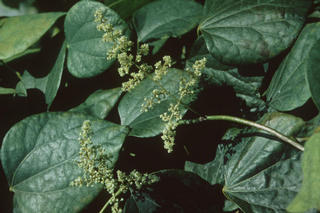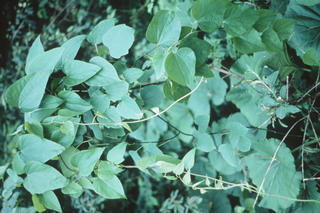Sinomenium acutum
Contents
Nomenclature
Other Names:
Historical Use of Sinomenium acutum
Sinomenium acutum in Traditional Chinese Medicine
Background
Chinese Name (pinyin): Qingfengteng
Chinese Name :
Common Name :Orientvine Stem
Specific Name : Caulis sinomenii
Scientific Name:
Collection : The drug is collected in late autumn and early winter, tied up in bundle or cut into long section, and dried in the sun.
Description : Oblong - cylindrical, usually somewhat curved, 20 - 70 cm long or more, 0.5 - 2 cm in diameter. Externally greenish-brown to brown, some greyish - brown, with fine longitudinal striations and lenticels. Nodes slightly swollen and brached. Texture light, hard and fragile, easily broken, fracture uneven, greyish-yellow or pale greyish-brown, bark narrow, wood rays arranged radially, pith pale yellowish-white or yellowish-brown. Odour, slight; taste, bitter.
Identification : 1. Transverse section: Epidermal cells 1 layer, covered with thick cuticle. Some prossessing cork cells. Cortex scattered with fibers and stone cells. Pericyclic fibre groups in crescent shape, the inner side of fibre groups usually prossessing 2-5 rows of stone cells, tangetially elongated and linked with stone cell groups of rays to a ring. Vascular bundles collateral. Phloem rays gradullary widened outwards, conical or branching stone cells visible; phloem, cells mostly collapsed, sometimes scattered with 1-3 fibres in the outer side and serveral layers of parenchymatous cells in the inner side. Xylem vessels singly scattered or serveral linked up tangentially. The walls of cells surrounding pith relatively thickened, distinctly pitted. Parenchymatous cells containing starch granules and needle crystals of calcium oxalate.Powder: Yellowish-brown or greyish-brown. Epidermal yellow or yellowish-brown, subrounded or oblong in lateral view, 24-78µm in diameter, covered with cuticle. Stone cells pale yellow or yellow, subsquare, fusiform, eliptical or irregular-shaped walls relatively thick, pit the canals distinct. Fibers in cortex pale yellow or yellow, 27 70µm in diameter with heavy thickened walls and a narrow lumen. Needle crystals of calcium oxalate small occuring in parenchymatous cells.2. Heat under reflux 2g of the powder in 2oml of 70% ethanol for 30 minutes, cool and filter. Evaporate the filtrate to dryness, dissolve the residue in 10ml of hydrochloric acid solution (1?50) and filter. Adjust the filtrate to alkaline with ammonia TS and extract with 10 ml of chloroform. Separate the chloroform layer, evaporate to dryness, dissolve the residue in 5ml of hydrochloric acid solution (1?50). Add the solution separately to three test tubes, to the first tube add 2 drops of potassium iodobismuthate TS, an orange precipitate is produced. To the second add 2 drops of mercuric potassium iodide TS a pale yellow precipitate is produced, to the last tube add 2 drops of silicotungsic acid TS, a greyish-white precipitate is produced.3.Heat under reflux 2g of the powder with 25ml of ethanol on a water bath for 1 hour and filter. Evaporate the filtrate to dryness. Dissolve the residue in 1 ml of ethanol as the test solution. Dissolve sinominine CRS in ethanol to produced a solution containing 1mg per ml as the r3ference solution. Carry out the method for thin layer chromatography (Appendix Vl B) using silica gel G prepared with 2% solution of sodium hydroxide as the coating substance and the upper layer of a mixture of toluene-ethyl-acetate-methanol-water (2:4:2:1) standing below 10ºC as the mobile phase. Apply separately to the plate 5µl of each of the two solutions. After developing and removal of the plate, dry it in the air, spray with potassium iodobimuthate TS and sodium nitrite in ethanol TS, successively. The brown spot in the chromatogram obtained with the test solution correspond in the position and colour to the spot in the chromatogram obtained with the reference solution.Total ash: not more than 6.0%
Processing : eliminate foreign matter, soak briefly, soften thoroughly, cut into thin slices and dry.
Action : To relieve rheumatic conditions, to remove obstruction of the channels and collaterals, and to cause diuresis.
Indication :
Precautions :
Dosage : 6 to 12 g.
Storage : Preserve in a dry place.
Synonymns for Sinomenium acutum
Patent Medicines and Medicines with Multiple Ingredients that include Sinomenium acutum
Pharmaceutical Information
Chemical Constituents
Evidence or the Use of Sinomenium acutum in the Treatment of Epilepesy
Basic Science
Animal Studies
Cohort, Case-Control and Non-Randomized Trials
Randomized Controlled Trials
Meta-Analysis
1st Five Results: pubmed search

